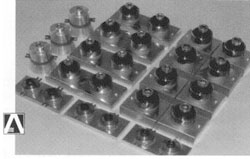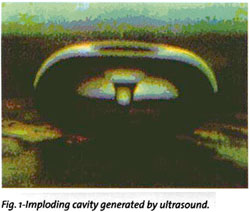ULTRASONIC CLEANING involves the use of high-frequency sound waves {above the upper range of human hearing, or about 18kHz) to remove a variety of contaminants from parts immersed in aqueous media. Materials that can be cleaned include metals, glass, ceramics, and so on.

Ultrasonic cleaning is powerful enough to remove tough contaminants, yet gentle enough not to damage the substrate.lt provides excellent penetration and cleaning in the smallest crevices and between tightly spaced parts in a cleaning tank.
PROCESS DESCRIPTION
In a process termed cavitation, micron-sized bubbles form and grow due to alternating positive and negative pressure waves in a solution. The bubbles subjected to these alternating pressure waves continue to grow until they reach resonant size. Just prior to the bubble implosion (Fig. 1), there is a tremendous amount of energy stored inside the bubble itself.

Temperature inside a cavitating bubble can be extremely high, with pressures up to 500 atm. The implosion event, when it occurs near a hard surface, changes the bubble into a jet about one-tenth the bubble size, which travels at speeds up to 400km/hr toward the hard surface. With the temperature, and velocity, the jet frees contaminants from their bonds with the substrate. Because of the inherently small size of the jet and the relatively large energy, ultrasonic cleaning has the ability to reach into small crevices and remove entrapped soils very effectively.

|

